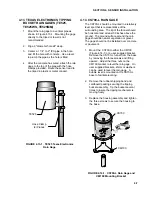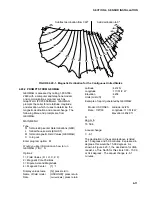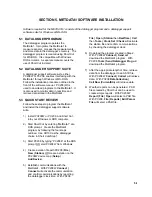
6-1
SECTION 6. MAINTENANCE AND TROUBLESHOOTING
These guidelines apply to several different Campbell Scientific weather stations.
6.1 MAINTENANCE
Proper maintenance of weather station
components is essential to obtain accurate
data. Equipment must be in good operating
condition, which requires a program of regular
inspection and maintenance. Routine and
simple maintenance can be accomplished by
the person in charge of the weather station.
More difficult maintenance such as sensor
calibration, sensor performance testing (i.e.,
bearing torque), and sensor component
replacement, generally requires a skilled
technician, or that the instrument be sent to
Campbell Scientific or the manufacturer.
A station log should be maintained for each
weather station that includes serial numbers,
dates that the site was visited, and maintenance
that was performed.
6.1.1 INSTRUMENTATION MAINTENANCE
The instrumentation requires a minimum of
routine maintenance. A few preventative
maintenance steps will optimize battery life and
decrease the chances of datalogger failure.
6.1.2 BATTERIES
Instruction 10 can be used to measure battery
voltage. By recording battery voltage the user
can determine how long a fresh set of batteries
will last (see the Installation Section of the
datalogger Operator's Manual for cold
temperature effects on alkaline batteries).
Short Cut and ETPro automatically program the
weather station to measure battery voltage.
When alkaline batteries are used, the battery
voltage should not be allowed to drop below 9.6
VDC before replacement. Where CR10 or 21X
dataloggers are used in the instrumentation, an
external battery must be used to maintain power
to the datalogger when changing batteries,
otherwise the clock, program, and data will be
lost (refer to the Installation Section of the
datalogger's Operator's Manual for details).
When not in use, remove the eight cells to
eliminate potential corrosion of the contact
points, and store in a cool dry place.
Rechargeable power supplies should be
connected to an AC transformer or unregulated
solar panel at all times. The charge indicating
diode should be "ON" when voltage to the
charging circuitry is present. Be aware of
battery voltage that consistently decreases over
time, which indicates a failure in the charging
circuitry.
6.1.3 DESICCANT
Enclosure humidity is monitored in the ET
Enclosure and MetData1 systems by an RH
chip incorporated into the connector board.
Change the desiccant packs when the
enclosure RH exceeds 35%. The RH chip
should be changed every 3 to 5 years.
In standard weather stations, a humidity
indicator card is provided with the enclosure. A
small RH sensor (10162) can be purchased
separately to record the RH inside the
enclosure. Change the desiccant when either
the card or the sensor read about 35% RH.
Desiccant may be ordered through Campbell
Scientific (DSC 20/4).
Desiccant packs inside of the dataloggers do not
require replacement under normal conditions.
6.1.4 SENSOR MAINTENANCE
Sensor maintenance should be performed at
regular intervals, depending on the desired
accuracy and the conditions of use. A suggested
maintenance schedule is outlined below.
1 week
•
Check the pyranometer for level and
contamination. Gently clean, if needed.
•
Visually inspect the wind sensors and
radiation shield.
1 month
•
Check the rain gage funnel for debris and
level.
•
Do a visual/audio inspection of the
anemometer at low wind speeds.
•
Check the filter of the temperature/humidity
sensor for contamination.






































